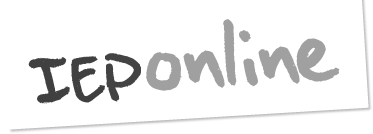IEP Meetings – transcript
[On the screen]
Leanne, Tom's mum, and Sue, teacher aide, talk about preparing for and participating in IEP meetings and the IEP process.
[Next slide, on the screen]
IEP meetings form only a small part of the IEP process, taking place especially at the "Meet and set goals" stage.
Before meeting, members of the team have been gathering assessment and monitoring information.
Section 9.2 of Collaboration for Success: Individual Education Plans, The Ministry of Education 2011
[A small diagram of the IEP process is on the right side of the screen]
Leanne, Tom’s mum:
I really like, and as a family we really like, having access to the learning stories before we go into an IEP because they are from a variety, a wealth of information that is relevant to Tom and his learning.
It doesn’t tick boxes or have checklists, or anything that, to be honest, isn’t very irrelevant for Tom and his learning. And it also is probably very useful for people that come in that don’t actually know Tom that well.
And so it’s very helpful for them, because at least through an IEP process, we don’t get silly questions that people should have known anyway.
It puts them on some sort of level playing field, so they don’t come in and not be up with the play really, which wastes time and is very frustrating.
It’s great having the learning stories for the fact that the IEP is based on what Tom is doing, actually doing, not what he’s not doing. Learning stories are in real language and they’re very easy to understand, and they’re very easy to follow, and they’re very easy to see perhaps what the next step could be. But it’s actually a team thing, you know?
It’s: we’re all working together for the same things, we’re all communicating, and we all know what the next step is going to be.
[On the screen]
Sue, teacher aide, answers a question about whether the use of learning stories has made a difference to the IEP process.
Sue:
Much more positive way of portraying Tom’s learning now.
They give us much clearer guidelines and far more sensible things to work towards because for someone with Tom’s level of disability, a lot of things with the IEP were completely unattainable for him.
[On the screen]
Sue, what is different now that Tom’s IEP team uses learning stories as part of the IEP process and meetings?
Sue:
Well, I found the early IEPs quite adversarial, really.
I found those early IEPs were like, we were trying to hide Tom’s achievements so that we didn’t lose funding for him. Whereas now we can celebrate what he’s learning, we can celebrate what he’s achieving, and we can go to the IEP with these really definite goals. And we can prove, not just through me saying, “This is what he’s doing”, but we can actually show through his learning stories, and back it up with loads of evidence as to how much his learning has changed and improved.
[On the screen]
Thank you to Tom's family and learning support team for sharing their experiences in this digital story.
« Back to IEP Meetings

